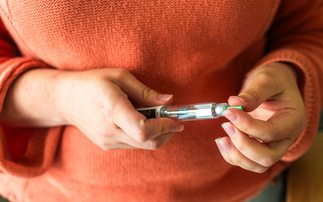Haemochromatosis is when the body absorbs excess iron which is then deposited in its organs causing enlargement and irreparable damage. Peter Jolliffe explains the effects of the disease and how it can be treated
Haemochromatosis is a genetic or acquired (secondary haemochromatosis) disorder that causes the body to absorb excessive amounts of iron from the diet. This is then deposited in various organs, mainly the liver, but also the pancreas, heart, endocrine glands and joints.
Because humans cannot increase excretion of iron, the deposits accumulate over time. Untreated, it can result in irreparable organ damage including cirrhosis of the liver, late onset diabetes or cardiomyopathy.
The liver normally stores a small amount of iron in order to provide new red blood cells with the material which is vital for health. When excessive quantities are stored in the liver, however, the organ becomes enlarged and damaged.
For a long time it was believed that the disorder was rare so haemochromatosis was seldom considered as a possible diagnosis. However, recent surveys have shown that 1 in 400 people are likely to be at risk of developing the condition.
Symptoms
There is a wide range of non-specific symptoms and clinical findings. Individuals of European origin with any of the following conditions, particularly a combination of two or more could be at risk:
- Unexplained weakness or fatigue.
- Bronze skin pigmentation.
- Abnormal liver function.
- Arthralgia/arthritis (particularly if it occurs initially in the first and second knuckles).
- Diminished sex drive or impotence.
- Diabetes.
- Abnormal heart rhythms.
Inherited disorders are caused by defective genes in the cells which make up the body.
In 1996, the HFE gene was identified as the major gene affected in haemochromatosis. A small change (mutation) is present in both copies of the gene in over 90% of those diagnosed with the disorder. Haemochromatosis is a 'recessive' disorder, meaning that the risk of absorbing excess iron will only occur if both copies of the gene are abnormal. If just one copy is defective, an individual will be perfectly healthy but will be a 'carrier'. This means they will be able to pass on the abnormal gene to their children.
Sperm and egg cells have only one copy of each gene and, on average, half the eggs or half the sperm of a carrier will contain the defective version. By contrast, all the eggs or sperm of an individual in whom both gene copies are defective and who, as a result, suffers from haemochromatosis, will carry the abnormal gene.
To develop haemochromatosis you have to inherit a defective gene from both parents. This can happen in three ways (see facts and figures). The genetic defect of haemochromatosis is present at birth, but symptoms rarely appear before adulthood.
Secondary haemochromatosis can be caused by thalassaemia major, alcoholism or repeated blood transfusions.
What tests can be done?
Transferrin saturation (TS) - this is the ratio of two simple blood tests, which indicates iron accumulation. Serum iron is divided by total iron binding capacity (TIBC) to give the TS percentage.
Serum ferritin - this indicates the amount of iron stored in the body. Levels significantly over 300 ug/l (micrograms a litre) in men and 200 ug/l in women are further evidence of haemochromatosis.
Gene test - a simple blood test of the HFE gene mutation is positive in 90% of those affected and it will identify family members of iron overload.
Liver biopsy - a small sample of the liver is removed using a biopsy needle and shows whether tissue damage such as cirrhosis is present.
Simple and effective treatment consists of regular removal of blood, known as venesection therapy or phlebotomy. Every pint removed contains a quarter of a gram of iron. The body then uses some of the excess stored iron to make new red blood cells. Venesection will usually be performed once a week depending on the degree of iron and treatment may need to be continued for up to two years. During the course of treatment, the serum ferritin levels are monitored, indicating the size of the remaining iron stores. Treatment should usually continue until the serum ferritin level reaches 20(mu)g/l which indicates minimal or absent iron stores. As excess iron will continue to be absorbed, the individual will need occasional venesections, on average every three to four months, for the rest of their life.
Venesection treatment will cause tissue iron to mobilise and iron stores to return to normal. However, it will not cure some clinical conditions such as diabetes or cirrhosis if they are present at the time treatment is started, emphasising the need for early diagnosis.
It is not possible to treat haemochromatosis with a low iron diet but a nutritional, natural diet is recommended during treatment including the reduction of offal intake (liver, kidney) and red meat, minimising alcohol intake and avoiding vitamin supplements or toxins containing iron.
Facts and figures
- In the UK, about 250,000 people have a genetic predisposition to haemochromatosis.
- Only around 5,000 are currently diagnosed but there is evidence that several times that number have tissue damage and disease caused by iron overload.
- Haemochromatosis affects men more frequently than women (9 to 1 ratio).
- Haemochromatosis is the most common genetic disease in Northern Europe
- Usually presents in people who are 40 to 60 years old.
- The rate of iron absorption from red meat is 20% to 30% whereas vegetables and grains have less iron and a 15% to 20% rate of absorption.
- If both parents are carriers (the most common occurrence, as about 10% of the population are carriers meaning 1% of marriages will be between carriers), a quarter of the children will, on average, develop haemochromatosis, half will be carriers and a quarter will be normal.
- If one parent has haemochromatosis and the other is a carrier (about 1 in 2000 marriages), about half the children will develop haemochromatosis, and the other will be carriers.
- If both parents suffer from haemochromatosis (a rare event, occurring in about 1 in 100,000 marriages), all the children will inherit two defective genes, and will have the condition.
Peter Jolliffe is life and disability underwriter at Aegon Individual Protection
Sources
www.Haemochromatosis.org.uk
Swiss Re Lifeguide
RGA General Underwriters manual
www.gpnotebook.co.uk
Underwriting implications
When considering an application for life protection where the disease is present, the underwriter will request a general practitioner's report and will ask for the current liver status, serum transferrin saturation and serum ferritin concentration. The underwriter could consider terms if a diagnosis was more than six months ago.
If iron overload caused by haemochromatosis is diagnosed and treated before organ damage has occurred, a person can live a normal, healthy life. Standard terms would be available, where the person was asymptomatic with current normal liver function tests (LFTs), no sign of end organ damage and serum ferritin levels of less than 200ug/l. This would apply for life protection, critical illness (CI), total and permanent disability, income protection (IP) and waiver of premium. Standard rates would also be available for all benefits where there is no evidence of end organ damage, normal LFTs and ferritin levels of between 200ug/l to 1000ug/l providing the person is compliant with their therapy (venesection). If a person was not compliant with therapy then the chief medical officer would consider if terms could be offered with a rating or deferred until the person is compliant with therapy. Terms would not be available where serum ferritin levels are greater than 1000ug/l.
Additional factors auch as severe liver damage, cardiomyopathy, arrhythmia or evidence of alcohol abuse then terms would not be available. Abnormal LFTs or liver biopsy would be rated for the degree of end organ damage. If diagnosed with diabetes mellitus then CI, total and permanent disability, IP and waiver of premium would not be available while life protection would be rateable depending on the age, time since diagnosis (of diabetes) and control.
Where a genetic test has been performed, the chief medical officer will take into account all appropriate industry legislation relating to the use of genetic testing results.











